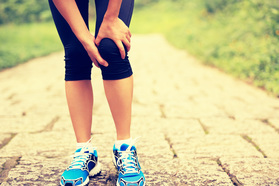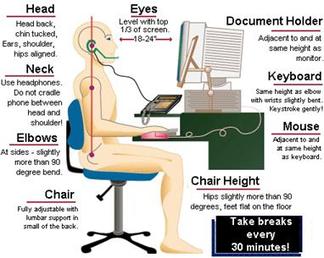Top 5 Tips for Injury Prevention
4/14/2016
By: Sonia Gashgarian, Physiotherapist  With warmer weather (hopefully) soon approaching, we can spend more time outdoors enjoying the sunshine and fresh air after a long winter season. For a lot of people, the warmer weather also means that outdoor sports and activities will be starting up again. If you are thinking of taking up a new sport or activity, or returning to a spring or summer league, here are my top 5 tips to help prevent injuries so you can enjoy your activity all season long: 1. PRE-SEASON TRAINING. To help get your body in peak shape for your upcoming activity, it is important to train the muscle and energy systems used during your activity. This involves gradually increasing your strength, balance, and endurance. For example, if your activity involves short bursts of running, try interval training to improve your anaerobic capacity; on the other hand, if the activity or sport lasts for a long period of time, improving your aerobic endurance is more suitable. If you are unsure of which strengthening exercises and/or training programs are right for you, a physiotherapist or other qualified health care professional can help you determine what areas you should focus on. 2. WARM-UP & COOL DOWN. An adequate warm-up should last between 10-15 minutes. Keep the exercises dynamic (stretching through movement) as much as possible to help warm-up the muscles and increase circulation. Some warm-up ideas include karaokes, knee-high running, butt kicks, and arm circles. After exercise, 5-10 minutes of light jogging clears lactic acid from the muscles, helping to prevent muscle soreness and stiffness the next day. 3. STAY HYDRATED. The average person loses between 1-1.5 litres of water for every one hour of exercise, so be sure to drink enough water before, during, and after you exercise to help prevent dehydration and muscle cramping. During those hot, humid summer days, this point is even more important to reduce the risk of heat stroke. If you sweat profusely or are exercising for over an hour, you will also need to replenish your electrolytes. 4. ALLOW FOR REST & RECOVERY. The general rule of thumb is to give at least 24 hours of rest between bouts of vigorous physical activity (e.g. a long run or bike ride, a game of soccer, or a tournament). However, light exercise, such as cycling with light resistance or lifting light weights, can be done on rest days. One of the most common times we injure ourselves is when we are tired. If your muscles and body aren’t given enough time to recover from the previous activity, your form and performance may pay the price, and the risk of injury increases as a result. 5. EQUIPMENT. Having the proper footwear and protective equipment will help to protect against any head and/or body injuries. While having the proper equipment for your activity is important, it is also necessary to make sure everything fits you properly.
60 Comments
Improving your Office Ergonomics
2/4/2016
By: Sonia Gashgarian, MscPT  Adults spend approximately 9.5 hours (or 69% of all waking hours) sitting each day according to Statistics Canada. Partly to blame is the fact that most job positions involve a lot of sitting – whether you are sitting in a meeting, sitting at your desk, or sitting during your commute to work. While leading a sedentary lifestyle can increase the risk of disease and health complications, too much sitting can also lead to musculoskeletal injuries. There are 3 factors that can increase the risk of injury; a combination of these factors increases injury risk even more: 1. Force 2. Repetition 3. Awkward Posture Considering the fact that a lot of office workers sit hunched forward in their office chair (an awkward posture) while working on the computer (a repetitive task), it is no wonder many people develop low back pain, neck and shoulder injuries, carpal tunnel syndrome, etc. However, there are several quick, simple, and easy changes that can be made to your desk set-up and sitting habits that will help to prevent the above mentioned injuries: 1. Adjusting the Chair. The image below outlines a better sitting alternative to sitting hunched forward. Here are some general guidelines: a. Sit right back in the chair and avoid leaning forward b. Tilt the seat pan forward so that the thighs are parallel to the floor or angled slightly downward c. Rest your feet fully on the floor, or use a foot rest if unable to reach the floor d. Recline the back rest to tilt back 100-110° e. Adjust the arm rest height so that elbows have a bit more than a 90° bend and shoulders are relaxed 2. Posture. When sitting, try to keep your ears, shoulders, and hips in line while gently squeezing the shoulder blades together and down. This will help keep the natural curves in your spine, reducing stress on the spine and surrounding muscles. 3. Monitor Placement. Keep the monitor an arm’s length away with the top of the screen no higher than eye level 4. Use a Document Holder. Keep any papers being used beside the monitor or between the keyboard and monitor. If possible, tilt the papers up towards you to allow you to glance at documents, rather than having to repeatedly bend or turn your head 5. Use a Headset. If your job requires a lot of time spent on the phone, consider using a headset instead of cradling the phone between your ear and shoulder or holding the phone for prolonged periods of time 6. Desk Layout. Keep frequently used objects and equipment within forearm’s reach and occasionally used items within arm’s reach 7. Take Breaks. Stand up and stretch for a couple of minutes every 30 minutes to 1 hour. Even if there is only time to stand up and take a few steps, it will give your body and your mind a short break 8. Set a Timer. To help implement these changes, set a timer to go off on a regular basis. For example, set a timer every 20 minutes to remind about posture, or every hour to get up and stretch If you are already starting to feel the effects of too much sitting, a physiotherapist can help in a couple of different ways: * A physiotherapist can treat any injury or pain you may develop as a result of too much sitting, helping to rehabilitate your injury and manage your pain through hands-on techniques, education, home exercises, etc. * Physical Therapists can make recommendations, above and beyond the tips outlined above, to help optimize your office and desk set-up based on your needs The physio’s role can be endless, but the over-arching goal is to help rehabilitate the current injury and prevent injuries from recurring in the future. References 1. Colley RC, Garriguet D, Janssen I, Craig CL, Clarke J, Tremblay MS. Physical activity of Canadian adults: accelerometer results from the 2007 to 2009 Canadian Health Measures Survey. (Catalogue 82-003-XPE) Statistics Canada, Health Reports. 2011 Mar;22(1). 2. University of Toronto Department of Physical Therapy. Office Ergonomics. 2015 June. Platinum Health & Wellness Promo Video
1/15/2015
Check out our new welcome video for our clinic! We are excited to be entering our third year of practice and continue to look forward to optimizing your health and wellness goals. We believe in the importance of living an active lifestyle that involves healthy eating, daily exercise, and regular body work. Find relaxation, improve your well-being, and enhance your mind-body connection with our therapeutic treatments. Health Services offered at Platinum Health & Wellness include, Chiropractic Care, Registered Massage Therapy, Acupuncture, Naturopathy, Physiotherapy, Holistic Nutrition, and Custom Orthotics.
By: Christa Mazzuca, MScPT  Are you experiencing joint or muscle pain? Recovering from an injury? Or just want to move better? Aside from supporting you through rehabilitation post injury, a physiotherapist can guide you to use your body efficiently and in a way that puts the least amount of strain on it - all so you can better perform your daily activities! Our jobs, chores and social activities all put demands on our body. Physical therapy can help improve your mobility, strength, posture and body mechanics to ultimately enhance your function for these tasks. Having poor posture or putting strain on your joints will amplify these demands. Having good body mechanics will making moving easier since your bones and muscles will be in their optimum positions. So, what's important is HOW you are moving; this can be assessed by a physiotherapist and then you can be given tips on how to improve. Individualized exercises can help address any muscle imbalances and develop strength to help you work toward a great posture, which can also be applied to movement. A physio can supervise you through your exercises to make sure you are doing them correctly and progress them as you improve. Different techniques like soft tissue work and acupuncture can help work with your body's natural mechanisms to promote recovery and healing. For example, acupuncture does this by increasing blood flow, muscle relaxation and nerve stimulation. So in summary, benefits of physical therapy include: 1. Improved posture and body-mechanics 2. Improved strength and mobility 3. Improved function 4. Quicker healing and recovery |
AuthorPosts inspired by the team at Platinum Health & Wellness. Archives
June 2025
Categories
All
|
|
 RSS Feed
RSS Feed